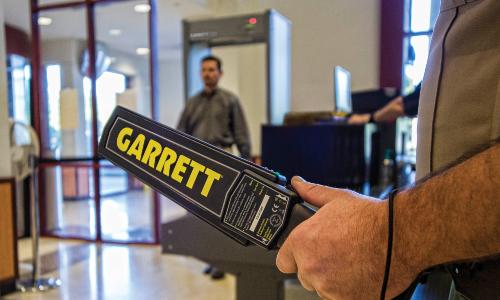Aside from doing your own testing of anticipated threat objects (such as disassembled guns and knives) before selecting your screening equipment, the careful planning of secondary screening may be the next most important factor in getting it right with school security.
Your security screening equipment is intended to act as a deterrence and to reliably detect all potential threats that cause concern in an education environment. Once that job is done, a secondary screening process begins to address situations where an alarm occurred. Primary screening and secondary screening work together like your washer and dryer. Secondary screening is what makes primary screening successful.
How is Secondary Screening Done?
Secondary screening is most often done either by:
A. Requiring the student to divest any items that may have alarmed, then passing the student back through the primary security screening equipment until a clear pass occurs. This method can be very effective at getting to the bottom of what caused the alarm, but it can create bottlenecks at screening and is generally disruptive to the flow of students through security.
or
B. Requiring the student to step aside (out of the flow) to be screened manually by a staff member. This method should not involve a “pat down” or any touching of the student. A security hand scanner should be used to pass over the clothing of the student to identify the location of the alarming item so that it can be divested and inspected. This method can be just as effective as method A., but it must be done carefully and accurately with good attention to detail.
This seems simple, right? Here are a few things that can go wrong with secondary screening:
Failure Mode A: No Secondary Screening
It is not uncommon to see security personnel waive people through a security screening checkpoint – even when alarms occur – when things get chaotic. Why does this happen? It is often related to insufficient staffing, a high rate of flow through primary screening, or a lack of secondary screening equipment & procedures. It is critical for schools to have a plan for who, how, where, and when an alarm of the primary screening process gets examined and resolved in secondary screening. When effective secondary screening is not in place, weapons can pass into the building. Security has failed.
Failure Mode B: Incomplete Secondary Screening
Another common failure in secondary screening is a lack of follow-through. In this scenario, the primary screening equipment alarms, the staff performs a secondary screening with a security hand scanner, and an alarming location is found. Having found a potential location of the alarm, the screener may ask questions but neglects to visually check the alarming item before waiving the student in. The threat item passes into the school. Security has failed.
Knives can hide behind phones, guns can hide behind belt buckles, and vapes can hide behind metal wallets. All removed items must be visually inspected to ensure effective security. Secondary screening is only as good as the people performing it.
Failure Mode C: Single-Zone Primary Screening
This failure case most frequently appears when using very old metal detectors or some modern weapon screening devices that do not provide the secondary screener with any target location information. These detectors have no interface to offer target locations, either via zone lights or with a separate monitor. In this scenario, the student alarms and prepares to be screened. The staff does not know where the alarming item is located or whether more than one alarming item exists. This means the staff must do a complete body scan using the security hand scanner and visually check every target they find to provide effective security. This is very time consuming. Most likely, the staff will find one target, check it, and stop the screening process while the student may still have an unidentified threat object on them, perhaps in a less accessible location. That weapon will not be found and will pass into the school. Security has failed.
Even worse, a clever bad actor may pull out an innocuous item like a cellphone from a pocket and “offer it up” to the staff, knowing that this admission will likely cause the staff to discontinue their search. If there is a hidden threat-item somewhere else on the body, it will pass freely into the school. Security has failed.
Zone indications or other target location indicators are absolutely critical when performing secondary screening. While single-zone detectors are often advertised as providing high throughput, the resulting breakdowns in secondary screening can completely defeat the security checkpoint. Keep in mind, your students will observe the way your screening equipment works and will adjust their behavior accordingly. Your secondary screening plan must comprehend this.
An effective secondary screening process is critically important if your security checkpoint is to operate as a true last-line-of-defense in the mission of keeping weapons out of your school!
Garrett has nearly 40 years of experience providing school security. Check out our resources page to see how we’ve helped others and how we can help you too.








